Typhoon-Induced Extreme Sea Surface Temperature Drops in the Western North Pacific and the Impact of Extra Cooling Due to Precipitation
Abstract
1. Introduction
2. Data and Methods
2.1. Observations
2.2. Model Description and Experiment Design
3. Results
3.1. Validation of Satellite-Observed SSTs
3.2. Characteristics of TICs and ESSTDs
3.3. TICs and ESSTDs vs. Sharp TC Intensity Changes
3.4. TICs and ESSTDs: Open Ocean versus Continental Shelf
4. Outlier—Kilo (2015)
5. Conclusions and Remarks
Supplementary Materials
Author Contributions
Funding
Data Availability Statement
Conflicts of Interest
References
- Chien, F.-C.; Kuo, H.-C. On the Extreme Rainfall of Typhoon Morakot (2009). J. Geophys. Res. Atmos. 2011, 116. [Google Scholar] [CrossRef]
- Schade, L.R.; Emanuel, K.A. The Ocean’s Effect on the Intensity of Tropical Cyclones: Results from a Simple Coupled Atmosphere–Ocean Model. J. Atmos. Sci. 1999, 56, 642–651. [Google Scholar] [CrossRef]
- Shay, L.K.; Goni, G.J.; Black, P.G. Effects of a Warm Oceanic Feature on Hurricane Opal. Mon. Weather. Rev. 2000, 128, 1366–1383. [Google Scholar] [CrossRef]
- Wu, C.-C.; Lee, C.-Y.; Lin, I.-I. The Effect of the Ocean Eddy on Tropical Cyclone Intensity. J. Atmos. Sci. 2007, 64, 3562–3578. [Google Scholar] [CrossRef]
- Lin, I.-I.; Wu, C.-C.; Pun, I.-F.; Ko, D.-S. Upper-Ocean Thermal Structure and the Western North Pacific Category 5 Typhoons. Part I: Ocean Features and the Category 5 Typhoons’ Intensification. Mon. Weather Rev. 2008, 136, 3288–3306. [Google Scholar] [CrossRef]
- Lee, C.-Y.; Chen, S.S. Stable Boundary Layer and Its Impact on Tropical Cyclone Structure in a Coupled Atmosphere–Ocean Model. Mon. Weather Rev. 2014, 142, 1927–1944. [Google Scholar] [CrossRef]
- Zheng, Z.-W.; Lin, I.-I.; Wang, B.; Huang, H.-C.; Chen, C.-H. A Long Neglected Damper in the El Niño—Typhoon Relationship: A ‘Gaia-Like’ Process. Sci. Rep. 2015, 5, 11103. [Google Scholar] [CrossRef] [PubMed]
- Glenn, S.M.; Miles, T.N.; Seroka, G.N.; Xu, Y.; Forney, R.K.; Yu, F.; Roarty, H.; Schofield, O.; Kohut, J. Stratified Coastal Ocean Interactions with Tropical Cyclones. Nat. Commun. 2016, 7, 10887. [Google Scholar] [CrossRef]
- Kuo, Y.-C.; Zheng, Z.-W.; Zheng, Q.; Gopalakrishnan, G.; Lee, H.-Y. Typhoon–Kuroshio Interaction in an Air–Sea Coupled System: Case Study of Typhoon Nanmadol (2011). Ocean. Model. 2018, 132, 130–138. [Google Scholar] [CrossRef]
- Emanuel, K.A. Thermodynamic Control of Hurricane Intensity. Nature 1999, 401, 665–669. [Google Scholar] [CrossRef]
- Zhu, T.; Zhang, D.-L. The Impact of the Storm-Induced SST Cooling on Hurricane Intensity. Adv. Atmos. Sci. 2006, 23, 14–22. [Google Scholar] [CrossRef]
- Mohanty, S.; Nadimpalli, R.; Osuri, K.K.; Pattanayak, S.; Mohanty, U.C.; Sil, S. Role of Sea Surface Temperature in Modulating Life Cycle of Tropical Cyclones over Bay of Bengal. Trop. Cyclone Res. Rev. 2019, 8, 68–83. [Google Scholar] [CrossRef]
- Price, J.F. Upper Ocean Response to a Hurricane. J. Phys. Oceanogr. 1981, 11, 153–175. [Google Scholar] [CrossRef]
- Zedler, S.E.; Dickey, T.D.; Doney, S.C.; Price, J.F.; Yu, X.; Mellor, G.L. Analyses and Simulations of the Upper Ocean’s Response to Hurricane Felix at the Bermuda Testbed Mooring Site: 13–23 August 1995. J. Geophys. Res. Oceans 2002, 107, 25-1–25-29. [Google Scholar] [CrossRef]
- Lin, I.-I.; Liu, W.T.; Wu, C.-C.; Wong, G.T.F.; Hu, C.; Chen, Z.; Liang, W.-D.; Yang, Y.; Liu, K.-K. New Evidence for Enhanced Ocean Primary Production Triggered by Tropical Cyclone. Geophys. Res. Lett. 2003, 30. [Google Scholar] [CrossRef]
- Black, P.G.; D’Asaro, E.A.; Drennan, W.M.; French, J.R.; Niiler, P.P.; Sanford, T.B.; Terrill, E.J.; Walsh, E.J.; Zhang, J.A. Air–Sea Exchange in Hurricanes: Synthesis of Observations from the Coupled Boundary Layer Air–Sea Transfer Experiment. Bull. Amer. Meteor. Soc. 2007, 88, 357–374. [Google Scholar] [CrossRef]
- D’Asaro, E.A.; Sanford, T.B.; Niiler, P.P.; Terrill, E.J. Cold Wake of Hurricane Frances. Geophys. Res. Lett. 2007, 34. [Google Scholar] [CrossRef]
- Zheng, Z.-W.; Lin, J.-Y.; Gopalakrishnan, G.; Chen, Y.-R.; Doong, D.-J.; Ho, C.-R.; Zheng, Q.; Wu, C.-R.; Huang, C.-F. Extreme Cooling of 12.5 °C Triggered by Typhoon Fungwong (2008). Ocean Model. 2023, 182, 102176. [Google Scholar] [CrossRef]
- Lumpkin, R.; Centurioni, L. NOAA Global Drifter Program Quality-Controlled 6-Hour Interpolated Data from Ocean Surface Drifting Buoys; NOAA National Centers for Environmental Information: Asheville, NC, USA, 2019.
- Perez, R.C.; Foltz, G.R.; Lumpkin, R.; Wei, J.; Voss, K.J.; Ondrusek, M.; Wang, M.; Bourassa, M.A. Chapter 5—Oceanographic Buoys: Providing Ocean Data to Assess the Accuracy of Variables Derived from Satellite Measurements. In Field Measurements for Passive Environmental Remote Sensing; Nalli, N.R., Ed.; Elsevier: Amsterdam, The Netherlands, 2023; pp. 79–100. [Google Scholar]
- Hansen, D.V.; Poulain, P.-M. Quality Control and Interpolations of WOCE-TOGA Drifter Data. J. Atmos. Ocean. Technol. 1996, 13, 900–909. [Google Scholar] [CrossRef]
- Large, W.G.; McWilliams, J.C.; Doney, S.C. Oceanic Vertical Mixing: A Review and a Model with a Nonlocal Boundary Layer Parameterization. Rev. Geophys. 1994, 32, 363–403. [Google Scholar] [CrossRef]
- Gelaro, R.; McCarty, W.; Suárez, M.J.; Todling, R.; Molod, A.; Takacs, L.; Randles, C.A.; Darmenov, A.; Bosilovich, M.G.; Reichle, R.; et al. The Modern-Era Retrospective Analysis for Research and Applications, Version 2 (MERRA-2). J. Clim. 2017, 30, 5419–5454. [Google Scholar] [CrossRef] [PubMed]
- Cummings, J.A. Operational Multivariate Ocean Data Assimilation. Q. J. R. Meteorol. Soc. 2005, 131, 3583–3604. [Google Scholar] [CrossRef]
- Shchepetkin, A.F.; McWilliams, J.C. A Method for Computing Horizontal Pressure-Gradient Force in an Oceanic Model with a Nonaligned Vertical Coordinate. J. Geophys. Res. Oceans 2003, 108. [Google Scholar] [CrossRef]
- Shchepetkin, A.F.; McWilliams, J.C. The Regional Oceanic Modeling System (ROMS): A Split-Explicit, Free-Surface, Topography-Following-Coordinate Oceanic Model. Ocean Model. 2005, 9, 347–404. [Google Scholar] [CrossRef]
- Zheng, Z.-W.; Zheng, Q.; Lee, C.-Y.; Gopalakrishnan, G. Transient Modulation of Kuroshio Upper Layer Flow by Directly Impinging Typhoon Morakot in East of Taiwan in 2009. J. Geophys. Res. Oceans 2014, 119, 4462–4473. [Google Scholar] [CrossRef]
- Shen, D.; Li, X.; Wang, J.; Bao, S.; Pietrafesa, L.J. Dynamical Ocean Responses to Typhoon Malakas (2016) in the Vicinity of Taiwan. J. Geophys. Res. Oceans 2021, 126, e2020JC016663. [Google Scholar] [CrossRef]
- Zheng, Z.-W.; Chen, Y.-R. Influences of Tidal Effect on Upper Ocean Responses to Typhoon Passages Surrounding Shore Region off Northeast Taiwan. J. Mar. Sci. Eng. 2022, 10, 1419. [Google Scholar] [CrossRef]
- Elipot, S.; Lumpkin, R.; Perez, R.C.; Lilly, J.M.; Early, J.J.; Sykulski, A.M. A Global Surface Drifter Data Set at Hourly Resolution. J. Geophys. Res. Oceans 2016, 121, 2937–2966. [Google Scholar] [CrossRef]
- Dare, R.A.; McBride, J.L. Sea Surface Temperature Response to Tropical Cyclones. Mon. Weather. Rev. 2011, 139, 3798–3808. [Google Scholar] [CrossRef]
- Foltz, G.R.; Balaguru, K.; Hagos, S. Interbasin Differences in the Relationship between SST and Tropical Cyclone Intensification. Mon. Weather Rev. 2018, 146, 853–870. [Google Scholar] [CrossRef]
- Bender, M.A.; Ginis, I. Real-Case Simulations of Hurricane–Ocean Interaction Using A High-Resolution Coupled Model: Effects on Hurricane Intensity. Mon. Weather Rev. 2000, 128, 917–946. [Google Scholar] [CrossRef]
- Cione, J.J.; Uhlhorn, E.W. Sea Surface Temperature Variability in Hurricanes: Implications with Respect to Intensity Change. Mon. Weather Rev. 2003, 131, 1783–1796. [Google Scholar] [CrossRef]
- Lloyd, I.D.; Vecchi, G.A. Observational Evidence for Oceanic Controls on Hurricane Intensity. J. Clim. 2011, 24, 1138–1153. [Google Scholar] [CrossRef]
- Mitchell, D.A.; Teague, W.J.; Jarosz, E.; Wang, D.W. Observed Currents over the Outer Continental Shelf during Hurricane Ivan. Geophys. Res. Lett. 2005, 32. [Google Scholar] [CrossRef]
- Teague, W.J.; Jarosz, E.; Wang, D.W.; Mitchell, D.A. Observed Oceanic Response over the Upper Continental Slope and Outer Shelf during Hurricane Ivan. J. Phys. Oceanogr. 2007, 37, 2181–2206. [Google Scholar] [CrossRef]
- Price, J.F. Internal Wave Wake of a Moving Storm. Part I. Scales, Energy Budget and Observations. J. Phys. Oceanogr. 1983, 13, 949–965. [Google Scholar] [CrossRef]
- Babin, S.M.; Carton, J.A.; Dickey, T.D.; Wiggert, J.D. Satellite Evidence of Hurricane-Induced Phytoplankton Blooms in an Oceanic Desert. J. Geophys. Res. Oceans 2004, 109. [Google Scholar] [CrossRef]
- Walker, N.D.; Leben, R.R.; Balasubramanian, S. Hurricane-Forced Upwelling and Chlorophyll a Enhancement within Cold-Core Cyclones in the Gulf of Mexico. Geophys. Res. Lett. 2005, 32. [Google Scholar] [CrossRef]
- Lin, I.-I.; Wu, C.-C.; Emanuel, K.A.; Lee, I.-H.; Wu, C.-R.; Pun, I.-F. The Interaction of Supertyphoon Maemi (2003) with a Warm Ocean Eddy. Mon. Weather Rev. 2005, 133, 2635–2649. [Google Scholar] [CrossRef]
- Zheng, Z.-W.; Ho, C.-R.; Zheng, Q.; Lo, Y.-T.; Kuo, N.-J.; Gopalakrishnan, G. Effects of Preexisting Cyclonic Eddies on Upper Ocean Responses to Category 5 Typhoons in the Western North Pacific. J. Geophys. Res. Oceans 2010, 115. [Google Scholar] [CrossRef]
- Zheng, Z.-W.; Ho, C.-R.; Zheng, Q.; Kuo, N.-J.; Lo, Y.-T. Satellite Observation and Model Simulation of Upper Ocean Biophysical Response to Super Typhoon Nakri. Cont. Shelf Res. 2010, 30, 1450–1457. [Google Scholar] [CrossRef]
- Zhang, H.; He, H.; Zhang, W.-Z.; Tian, D. Upper Ocean Response to Tropical Cyclones: A Review. Geosci. Lett. 2021, 8, 1. [Google Scholar] [CrossRef]
- Gosnell, R.; Fairall, C.W.; Webster, P.J. The Sensible Heat of Rainfall in the Tropical Ocean. J. Geophys. Res. Oceans 1995, 100, 18437–18442. [Google Scholar] [CrossRef]
- Jacob, S.D.; Koblinsky, C.J. Effects of Precipitation on the Upper-Ocean Response to a Hurricane. Mon. Weather Rev. 2007, 135, 2207–2225. [Google Scholar] [CrossRef]
- Ibrahim, H.D.; Sun, Y. Sea Surface Cooling by Rainfall Modulates Earth’s Heat Energy Flow. J. Clim. 2023, 36, 5125–5141. [Google Scholar] [CrossRef]
- Balaguru, K.; Foltz, G.R.; Leung, L.R.; Hagos, S.M. Impact of Rainfall on Tropical Cyclone-Induced Sea Surface Cooling. Geophys. Res. Lett. 2022, 49, e2022GL098187. [Google Scholar] [CrossRef]
- Hedström, K.S. Technical Manual for a Coupled Sea-Ice/Ocean Circulation Model (Version 3); Contract No. M07PC13368; US Department of the Interior Minerals Management Service Anchorage: Anchorage, AK, USA, 2009.
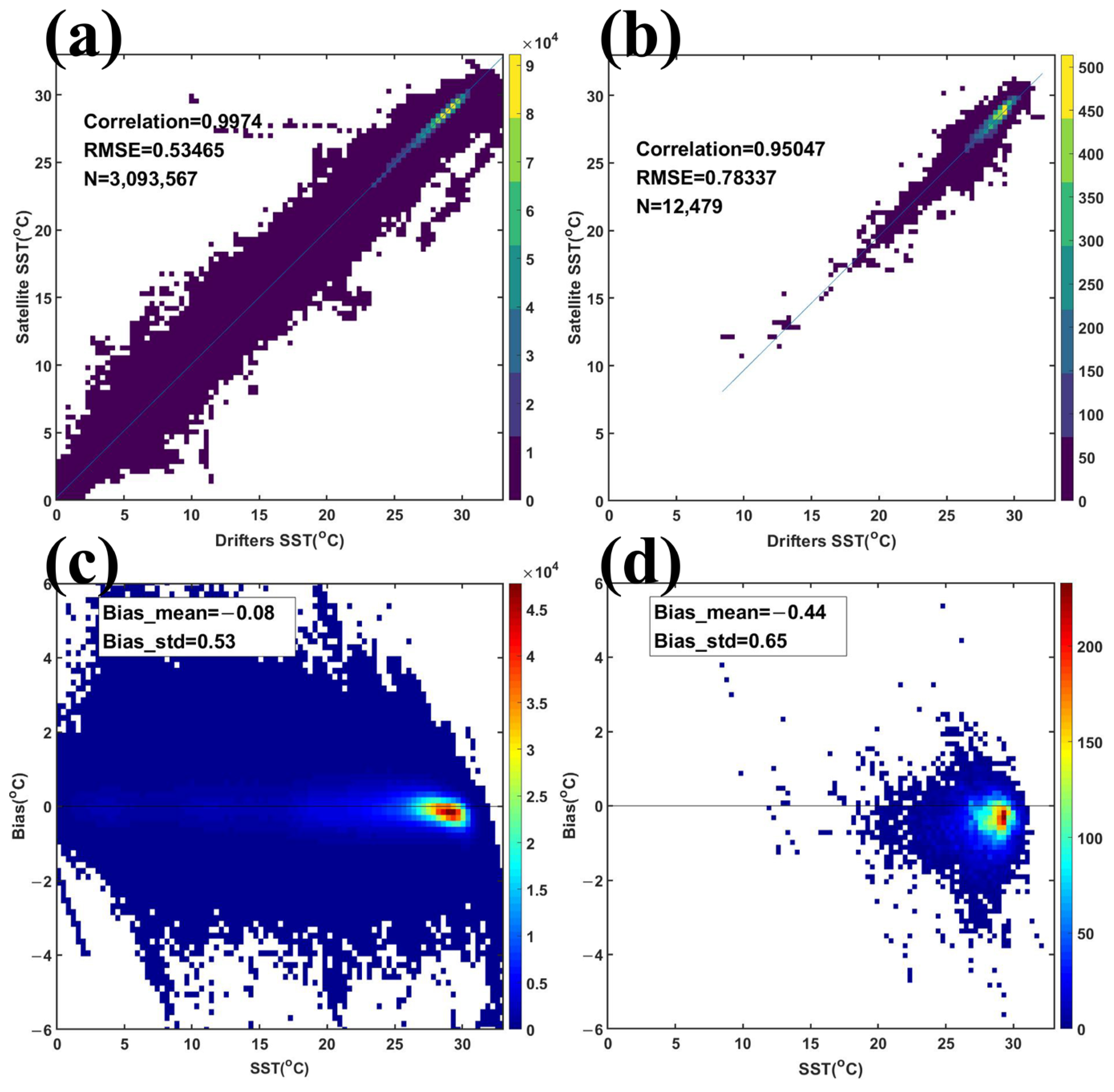
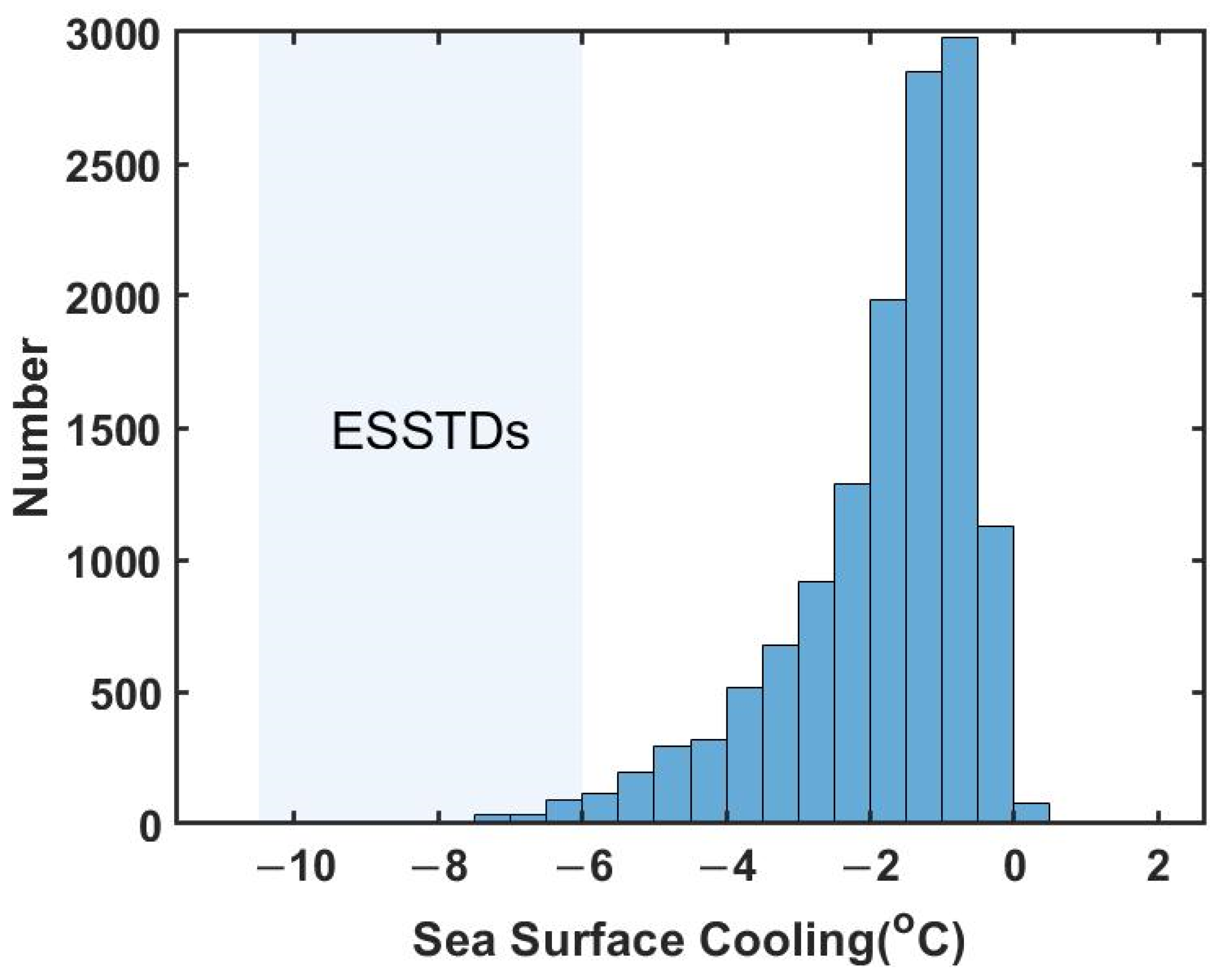

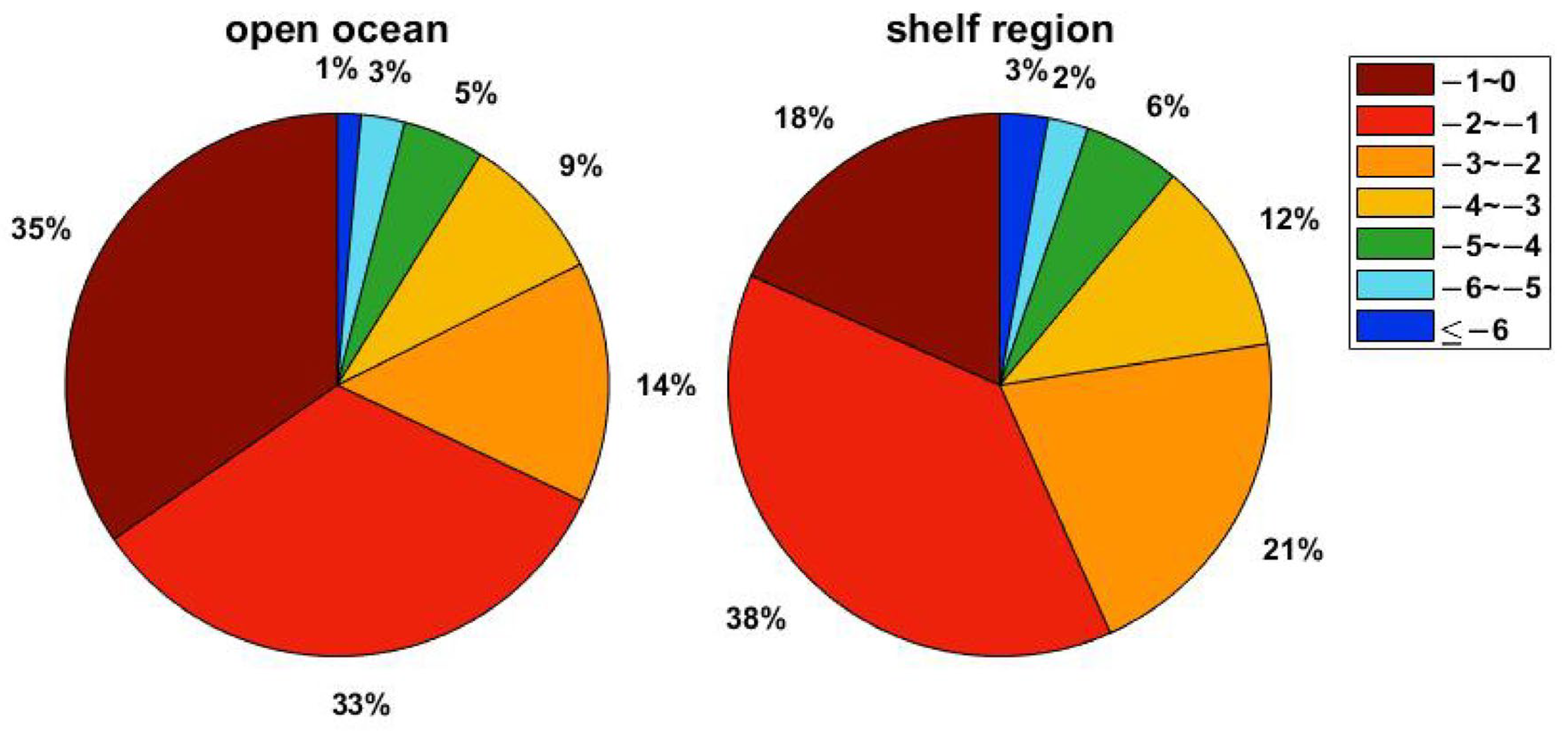

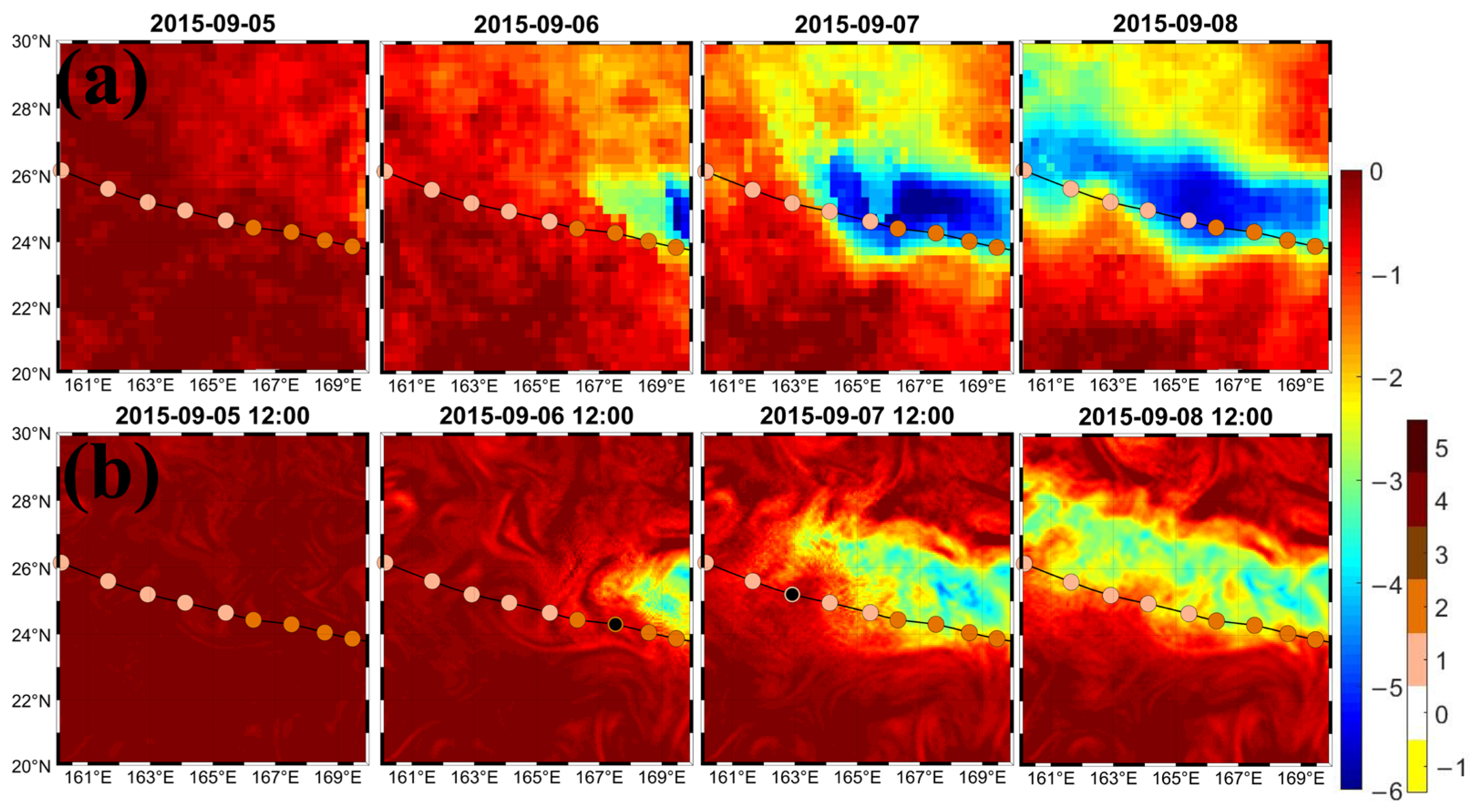
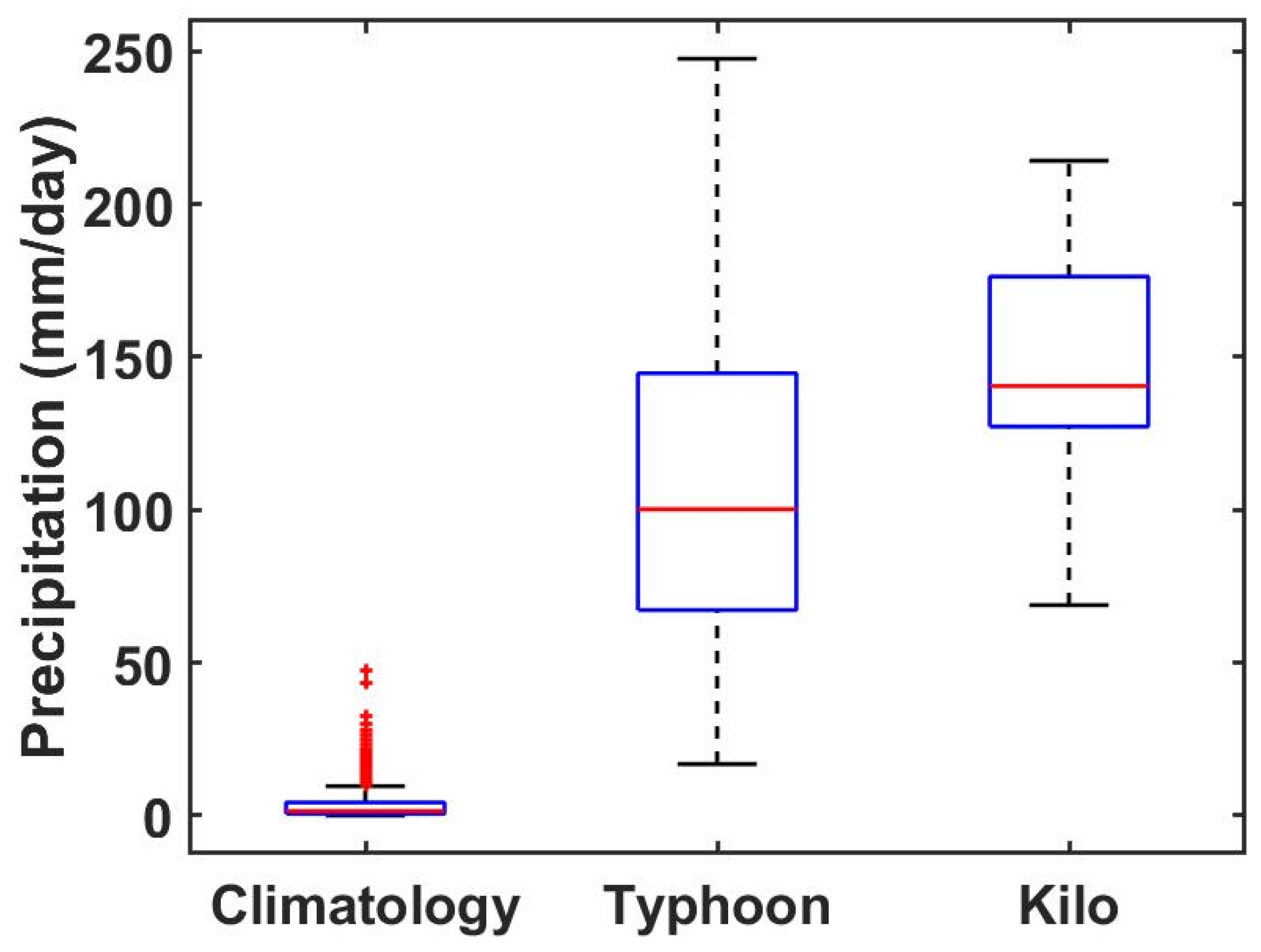

| Name | Date | △SST | Intensity Category | Moving Speed (m/s) | Cyclonic Eddies (SSH < 0.2 m) | Twice Impact * | Previous TC ** |
|---|---|---|---|---|---|---|---|
| MAN-YI | 6 August 2001 | −6.92 | 2 | 2.57 | X | X | O |
| FENGSHEN | 23 July 2002 09:00 | −6.05 | 3 | 7.72 | X | X | X |
| ELE | 4 September 2002 | −7.42 | 2 | 1.54 | X | X | X |
| KETSANA | 21 October 2003 | −7.05 | 2 | 1.54 | O | X | X |
| SOULIK | 13 October 2006 | −6.38 | 1 | 1.03 | X | X | X |
| CHOI-WAN | 18 September 2009 | −6.52 | 3 | 4.12 | X | X | X |
| MA-ON | 16 July 2011 | −7.27 | 4 | 5.14 | X | X | X |
| PRAPIROON | 12 October 2012 | −6.95 | 3 | 1.54 | O | X | X |
| SOULIK | 11 July 2013 | −6.84 | 3 | 6.17 | O | X | X |
| NEOGURI | 7 July 2014 | −7.02 | 5 | 6.69 | X | X | X |
| VONGFONG | 9 October 2014 | −6.12 | 5 | 2.57 | O | X | X |
| ATSANI | 21 August 2015 | −6.48 | 3 | 5.14 | X | X | X |
| KILO | 7 September 2015 | −6.33 | 1 | 5.14 | X | X | X |
| DUJUAN | 25 September 2015 | −6.36 | 1 | 1.54 | O | X | X |
| NORU | 31 July 2017 | −6.17 | 4 | 2.57 | X | X | X |
| KROSA | 11 August 2019 | −7.1 | 0 | 2.57 | X | X | X |
| MINDULLE | 28 September 2021 | −6.4 | 2 | 3.09 | O | X | X |
Disclaimer/Publisher’s Note: The statements, opinions and data contained in all publications are solely those of the individual author(s) and contributor(s) and not of MDPI and/or the editor(s). MDPI and/or the editor(s) disclaim responsibility for any injury to people or property resulting from any ideas, methods, instructions or products referred to in the content. |
© 2024 by the authors. Licensee MDPI, Basel, Switzerland. This article is an open access article distributed under the terms and conditions of the Creative Commons Attribution (CC BY) license (https://creativecommons.org/licenses/by/4.0/).
Share and Cite
Lin, J.-Y.; Ho, H.; Zheng, Z.-W.; Tseng, Y.-C.; Lu, D.-G. Typhoon-Induced Extreme Sea Surface Temperature Drops in the Western North Pacific and the Impact of Extra Cooling Due to Precipitation. Remote Sens. 2024, 16, 205. https://doi.org/10.3390/rs16010205
Lin J-Y, Ho H, Zheng Z-W, Tseng Y-C, Lu D-G. Typhoon-Induced Extreme Sea Surface Temperature Drops in the Western North Pacific and the Impact of Extra Cooling Due to Precipitation. Remote Sensing. 2024; 16(1):205. https://doi.org/10.3390/rs16010205
Chicago/Turabian StyleLin, Jia-Yi, Hua Ho, Zhe-Wen Zheng, Yung-Cheng Tseng, and Da-Guang Lu. 2024. "Typhoon-Induced Extreme Sea Surface Temperature Drops in the Western North Pacific and the Impact of Extra Cooling Due to Precipitation" Remote Sensing 16, no. 1: 205. https://doi.org/10.3390/rs16010205
APA StyleLin, J.-Y., Ho, H., Zheng, Z.-W., Tseng, Y.-C., & Lu, D.-G. (2024). Typhoon-Induced Extreme Sea Surface Temperature Drops in the Western North Pacific and the Impact of Extra Cooling Due to Precipitation. Remote Sensing, 16(1), 205. https://doi.org/10.3390/rs16010205





